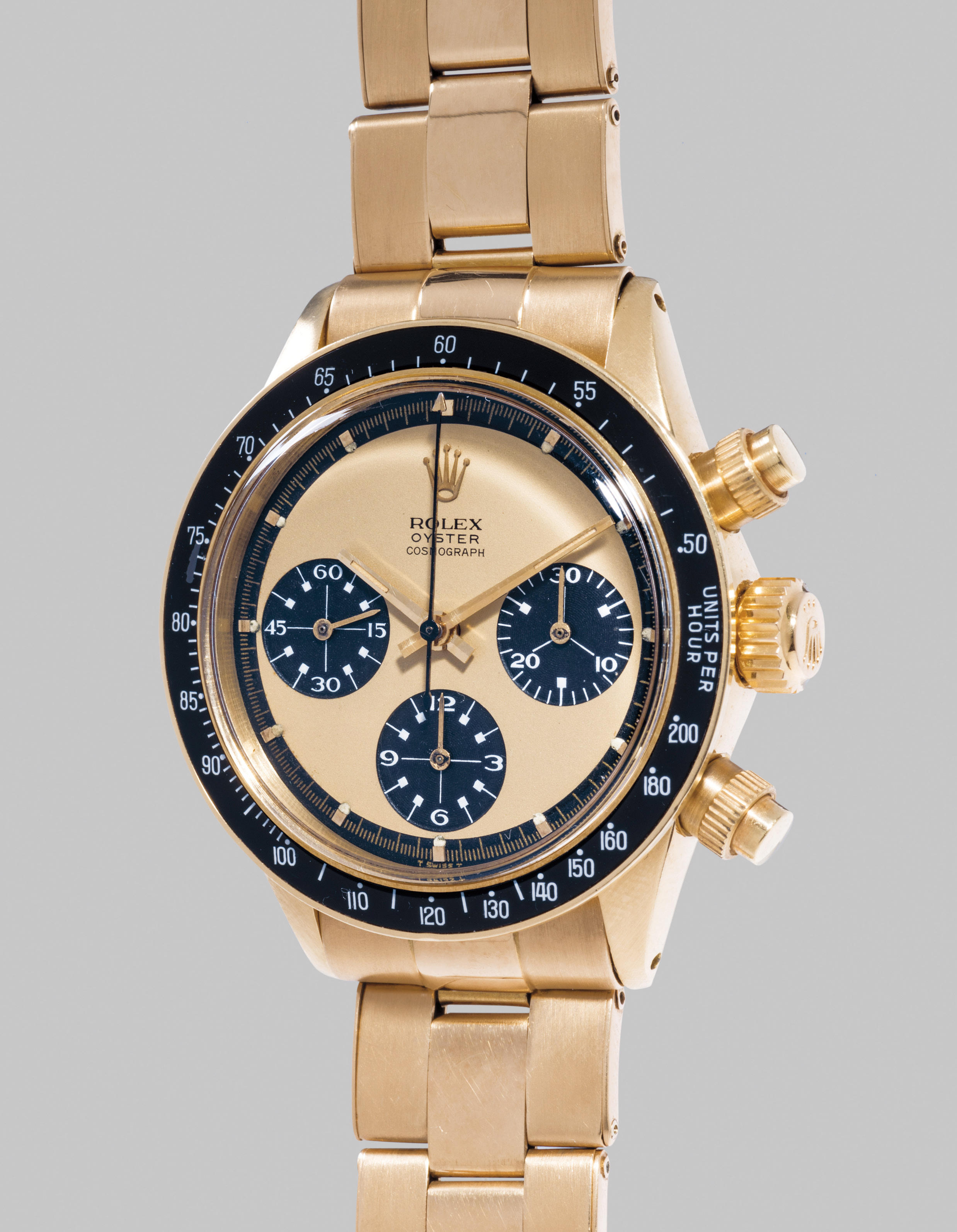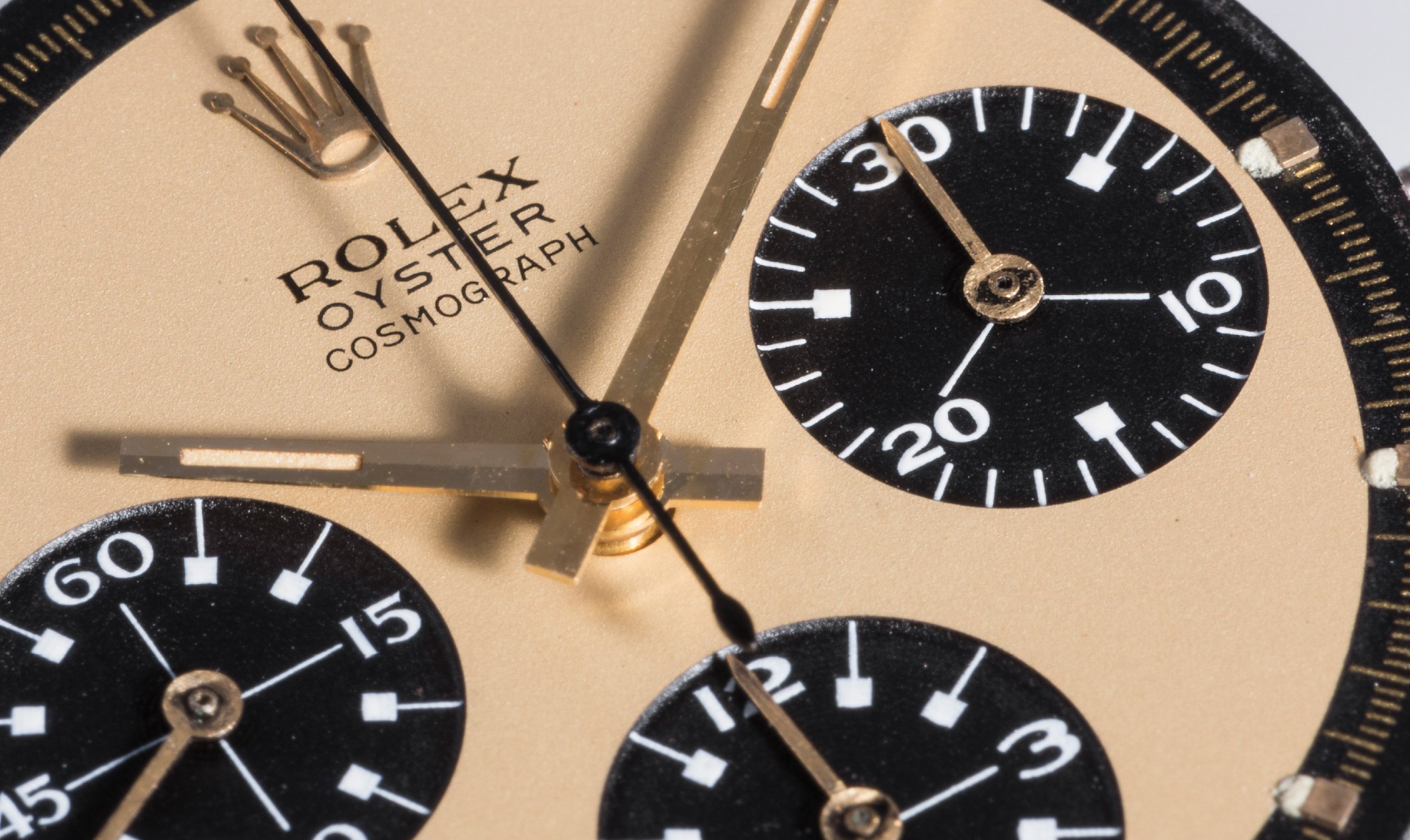







237
Rolex
Ref. 6263 caseback stamped 6239
Oyster Cosmograph "Paul Newman", also known in literature as "The Legend"
An exceedingly rare, highly important and very attractive yellow gold chronograph wristwatch with "lemon" grené dial, white graphics and bracelet
- Estimate
- CHF800,000 - 1,600,000€741,000 - 1,480,000$793,000 - 1,590,000
CHF3,722,000
Lot Details
- Manufacturer
- Rolex
- Year
- 1969
- Reference No
- 6263 caseback stamped 6239
- Case No
- 2'330'529
- Model Name
- Oyster Cosmograph "Paul Newman", also known in literature as "The Legend"
- Material
- 18K yellow gold
- Calibre
- Manual, cal. 727, 17 jewels
- Bracelet/Strap
- 18K yellow gold Rolex Oyster bracelet, max length 190mm.
- Clasp/Buckle
- 18K yellow gold Rolex folding deployant clasp stamped A
- Dimensions
- 37.5mm. Diameter
- Signed
- Case, dial, movement and bracelet signed
Specialist
Full-Cataloguing
Catalogue Essay
There are some watches, so elusive and so mythical, that stun even the most seasoned and weary of collectors. Today, the term "important" is used often and sometimes loosely, bordering on hyperbole. Yet, there are instances in which a watch arrives and is so sublime, it is almost impossible to qualify and quantify its beauty. To hold the watch, and to view it with one's very own eyes is to truly understand its exquisite nature. This example is indisputably such a watch.
For decades, scholars and collectors have debated the possibility of a yellow gold Paul Newman wristwatch with screw down pushers. To some, it was virtually incomprehensible that a correct example would ever grace the market. The fact was even more pertinent as literature did not confirm the fact, nor did Rolex ever comment on the subject.
Yet, the Rolex community discovered two yellow gold Daytonas with screw down pushers, both within a very close serial range, which displayed all the correct characteristics of an early "Paul Newman" dial. Reference 6263 was launched in 1969, and both examples were manufactured in the very earliest stages of the model's production. Both had extremely early serial numbers, made during the reference's infancy - a period where Rolex was experimenting with different dial configurations. One example is proudly displayed in Ultimate Rolex Daytona by Pucci Papaelo, proudly named "The Legend".
With two confirmed examples, the market was finally satiated, having recognized the "yellow gold Paul Newman with screw down pushers". Scholars and collectors now acknowledge its existence, and the model is considered the most important reference 6263 "Paul Newman" to exist, its rarity unparalleled even in comparison to the Oyster Sotto - the legendary reference 6263 with a black dial and "Rolex Cosmograph Oyster" signature.
Consequently, the present watch marks the third known and correct example to ever appear in the public eye. With serial number 2'330'529, it is among the very earliest 6263s to be produced. It is only 127 numbers apart from one confirmed example, and 30 some numbers away from the other, further enhancing its legitimacy. Given Rolex's high production numbers, these three watches could have very well been cased on the same day. Being one of the most important Paul Newman Daytonas to appear on the market in recent years, its beauty is completely palpable.
The most dazzling aspect, is of course, the dial. A creamy lemon shade, its a sharp contrast with the ivory dials that were fitted to stainless steel Paul Newmans. The dial shimmers in way that can only be described as sublime, catching the sun rays and enhancing the "stepped" nature of the dial.
The graphics of the subsidiary registers are white, which is a clear aesthetic departure from the gilt subdials of reference 6239 and 6241 Paul Newmans. This distinction is incredibly important, as it really differentiates the watch from its pump-pusher predecessors.
The Rolex Oyster font does not feature any serifs, while the Cosmograph signature is slightly serifed, signifying the watch is among the earliest batches ever produced. It is also important to note that the dial is signed "Rolex Oyster Cosmograph" instead of "Rolex Cosmograph Oyster", a direct reference to the screw down Oyster pushers. In contrast, the reference 6264 Paul Newman features white graphics, but is signed "Rolex Cosmograph". Thus, one can conclude the dial was specially made for the reference 6263, and Rolex did not simply add an "Oyster" designation to existing reference 6241 dials.
The luminous dots are furthermore even and consistent, having aged to a warm yellow tone, not unlike the dial. It boasts a wonderful fluffy consistency and appearance which collectors particularly admire, evenly matching the hands even under the rays of an ultraviolet light.
The case is also preserved in excellent condition, with sharp finishes to the top of the lugs and gold marks beneath the lugs. The case back is stamped 6239, which is correct, as Rolex used the case backs of previous models in the production of the earliest 6263s. This feature is can also seen on some of the case backs of "Oyster Sottos". Mk 1 "millerighe" pushers complete the watch, which is correct for early examples.
The complexities, nuances and many idiosyncrasies of the Cosmograph Daytona render it one of the most complex, interesting and fun models to collect and research. As a result, few watches can elicit emotion and unadulterated joy like the model can. It is not everyday that a "legend" appears on the market, and there is no telling when another will ever surface again.
For decades, scholars and collectors have debated the possibility of a yellow gold Paul Newman wristwatch with screw down pushers. To some, it was virtually incomprehensible that a correct example would ever grace the market. The fact was even more pertinent as literature did not confirm the fact, nor did Rolex ever comment on the subject.
Yet, the Rolex community discovered two yellow gold Daytonas with screw down pushers, both within a very close serial range, which displayed all the correct characteristics of an early "Paul Newman" dial. Reference 6263 was launched in 1969, and both examples were manufactured in the very earliest stages of the model's production. Both had extremely early serial numbers, made during the reference's infancy - a period where Rolex was experimenting with different dial configurations. One example is proudly displayed in Ultimate Rolex Daytona by Pucci Papaelo, proudly named "The Legend".
With two confirmed examples, the market was finally satiated, having recognized the "yellow gold Paul Newman with screw down pushers". Scholars and collectors now acknowledge its existence, and the model is considered the most important reference 6263 "Paul Newman" to exist, its rarity unparalleled even in comparison to the Oyster Sotto - the legendary reference 6263 with a black dial and "Rolex Cosmograph Oyster" signature.
Consequently, the present watch marks the third known and correct example to ever appear in the public eye. With serial number 2'330'529, it is among the very earliest 6263s to be produced. It is only 127 numbers apart from one confirmed example, and 30 some numbers away from the other, further enhancing its legitimacy. Given Rolex's high production numbers, these three watches could have very well been cased on the same day. Being one of the most important Paul Newman Daytonas to appear on the market in recent years, its beauty is completely palpable.
The most dazzling aspect, is of course, the dial. A creamy lemon shade, its a sharp contrast with the ivory dials that were fitted to stainless steel Paul Newmans. The dial shimmers in way that can only be described as sublime, catching the sun rays and enhancing the "stepped" nature of the dial.
The graphics of the subsidiary registers are white, which is a clear aesthetic departure from the gilt subdials of reference 6239 and 6241 Paul Newmans. This distinction is incredibly important, as it really differentiates the watch from its pump-pusher predecessors.
The Rolex Oyster font does not feature any serifs, while the Cosmograph signature is slightly serifed, signifying the watch is among the earliest batches ever produced. It is also important to note that the dial is signed "Rolex Oyster Cosmograph" instead of "Rolex Cosmograph Oyster", a direct reference to the screw down Oyster pushers. In contrast, the reference 6264 Paul Newman features white graphics, but is signed "Rolex Cosmograph". Thus, one can conclude the dial was specially made for the reference 6263, and Rolex did not simply add an "Oyster" designation to existing reference 6241 dials.
The luminous dots are furthermore even and consistent, having aged to a warm yellow tone, not unlike the dial. It boasts a wonderful fluffy consistency and appearance which collectors particularly admire, evenly matching the hands even under the rays of an ultraviolet light.
The case is also preserved in excellent condition, with sharp finishes to the top of the lugs and gold marks beneath the lugs. The case back is stamped 6239, which is correct, as Rolex used the case backs of previous models in the production of the earliest 6263s. This feature is can also seen on some of the case backs of "Oyster Sottos". Mk 1 "millerighe" pushers complete the watch, which is correct for early examples.
The complexities, nuances and many idiosyncrasies of the Cosmograph Daytona render it one of the most complex, interesting and fun models to collect and research. As a result, few watches can elicit emotion and unadulterated joy like the model can. It is not everyday that a "legend" appears on the market, and there is no telling when another will ever surface again.
Literature
Rolex
Swiss | 1905Founded in 1905 England by Hans Wilsdorf and Alfred Davis as Wilsdorf & Davis, it soon became known as the Rolex Watch Company in 1915, moving its headquarters to Geneva in 1919. Like no other company, the success of the wristwatch can be attributed to many of Rolex's innovations that made them one of the most respected and well-known of all luxury brands. These innovations include their famous "Oyster" case — the world's first water resistant and dustproof watch case, invented in 1926 — and their "Perpetual" — the first reliable self-winding movement for wristwatches launched in 1933. They would form the foundation for Rolex's Datejust and Day-Date, respectively introduced in 1945 and 1956, but also importantly for their sports watches, such as the Explorer, Submariner and GMT-Master launched in the mid-1950s.One of its most famous models is the Cosmograph Daytona. Launched in 1963, these chronographs are without any doubt amongst the most iconic and coveted of all collectible wristwatches. Other key collectible models include their most complicated vintage watches, including references 8171 and 6062 with triple calendar and moon phase, "Jean Claude Killy" triple date chronograph models and the Submariner, including early "big-crown" models and military-issued variants.
Browse Maker